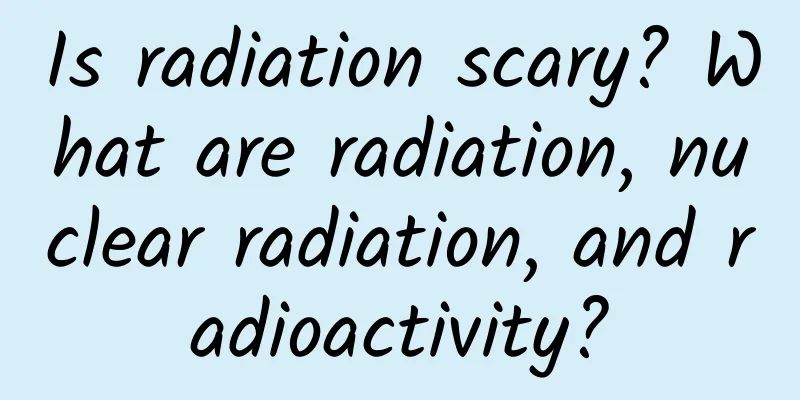Is radiation scary? What are radiation, nuclear radiation, and radioactivity?

|
People are worried about radiation from base stations and get scared when they talk about radiation. In fact, radiation, radioactivity and nuclear radiation are not the same concepts. Radiation Radiation refers to the phenomenon that energy diffuses outward in the form of electromagnetic waves or particles. According to this definition, radiation is everywhere in life. Light is a kind of radiation, and radio is also a kind of radiation. In fact, all objects in nature, as long as the temperature is above absolute zero (minus 273.15℃), will radiate electromagnetic waves to the outside world all the time. This radiation is called thermal radiation. In short, radiation is everywhere. There are two main types of radiation: electromagnetic waves and particles. The frequency of electromagnetic waves ranges from low to high, and can be divided into radio waves (including long waves, medium waves, and short waves), microwaves, infrared light, visible light, ultraviolet light, X-rays, and gamma rays. Electromagnetic waves of various forms are everywhere in life. Sunlight is an electromagnetic wave, WiFi signals are also electromagnetic waves, and signals emitted by mobile phone base stations are also electromagnetic waves. Electromagnetic radiation usually refers to the electromagnetic waves that objects can emit. Particles only appear in the process of nuclear radiation, such as alpha rays and beta rays. Alpha rays are essentially high-speed alpha particles (helium-4), while beta rays are high-speed electrons. Since microscopic matter has the dual nature of wave and particle, gamma rays, due to their extremely high frequency, have a particularly strong particle nature and can be regarded as photons. Depending on the radiation energy and ionizing ability, radiation can be divided into two categories: ionizing radiation and non-ionizing radiation. Ionizing radiation mostly occurs in nuclear reactions. Alpha rays, as well as high-frequency electromagnetic waves such as X-rays and gamma rays, are ionizing radiation. The characteristics of ionizing radiation are short wavelength, high frequency, and high energy. Harmful radiation generally refers to ionizing radiation. Electromagnetic waves with wavelengths greater than 100 nanometers are all non-ionizing radiation. These radiations have low frequencies and low energy and usually do not cause harm to our health. Our health will only be affected when we are exposed to high-power radiation sources for a long time. Nuclear Radiation Everything is made up of atoms. Nuclear radiation is the flow of microscopic particles released when the atomic nucleus changes from one structure or one energy state to another structure or another energy state. The particles emitted by nuclear radiation mainly include alpha rays (alpha particles), beta rays (electrons), gamma rays, positrons, protons, neutrons, neutrinos, etc. Among them, gamma rays have high radiation energy and strong penetrating power, and can penetrate lead plates several centimeters thick. Like alpha rays, they can be blocked by a piece of paper. The radiation used by atomic bombs to kill people is mainly gamma rays. Nuclear radiation can be released through nuclear reactions such as nuclear fission, nuclear fusion, and nuclear decay. The sun can emit light and heat continuously because of the nuclear fusion reaction going on inside it. This energy will be released in the form of radiation, including both ionizing radiation and non-ionizing radiation. In fact, nuclear radiation exists everywhere on Earth and in the universe. Nuclear radiation in space mainly comes from stars and other celestial bodies, while nuclear radiation on Earth mainly comes from the decay of radioactive substances. Nuclear radiation can cause matter to be excited or ionized, which is very harmful to life, and can destroy genetic material, cells and tissues. The reason why humans can be protected from the harm of nuclear radiation from the sun and space is that there is a dense atmosphere hundreds of kilometers thick on the surface of the earth, which can effectively block all kinds of high-energy rays. Radioactivity is a phenomenon in which an element spontaneously emits nuclear radiation when it changes from an unstable nucleus to a stable nucleus. This process of change is called decay, which is also a nuclear reaction. In short, radioactive substances are one of the sources of nuclear radiation. These natural radioactive elements, such as radium and uranium, can release nuclear radiation in the form of decay. The main forms of decay include alpha decay, beta decay, gamma decay, spontaneous fission, etc. In the periodic table of chemical elements, elements with atomic numbers of 83 (bismuth) and above are radioactive, and a few elements with atomic numbers less than 83 (such as technetium) are also radioactive. There are 118 known elements in nature, corresponding to more than 2,600 nuclides (elements are a class of atoms with the same number of protons, and nuclides are a class of atoms with a certain number of protons and a certain number of neutrons), of which more than 2,300 are radioactive nuclides. Although there are only more than 280 stable nuclides, they belong to 81 elements. The reason why the earth's interior can maintain a high temperature is because there are a large number of radioactive heavy elements, which continuously release radiation. Although there are many radioactive substances in nature, the radiation dose is generally very low and generally does not harm health. Usually only radioactive substances from nuclear explosions or nuclear power plant leaks can release high doses of nuclear radiation. Our bodies contain very small amounts of radioactive isotopes, and the food we consume every day also contains very small amounts of radioactive substances. In short, no matter what the harm is, it would be rude not to talk about the dosage. The discovery of radioactivity Humans discovered radioactivity only about 100 years ago. In 1896, French physicist Becquerel discovered that uranium salts emit a type of radiation while studying uranium salts. This radiation can ionize the air and penetrate black paper to make photographic film sensitive. His discovery marked the first discovery of radioactivity or nuclear radiation by humans. In 1898, the Curies discovered polonium and radium, which were even more radioactive. For this groundbreaking discovery, the Curies and Becquerel jointly won the 1903 Nobel Prize in Physics. In 1919, British physicist Rutherford bombarded nitrogen nuclei with alpha particles produced by a radioactive source (polonium Po), separated protons from the nitrogen nuclei, realized an artificial nuclear reaction for the first time, and produced nuclear radiation using artificial methods. Because people at that time did not fully understand the dangers of nuclear radiation, no protection was taken during the research process. For example, Madame Curie died of aplastic anemia on July 4, 1934 due to long-term exposure to radioactive substances. |
>>: A sophisticated and magical structure hidden in your body
Recommend
A well-known male singer died of cerebral hemorrhage after singing on stage! Be careful when singing with such people
Earlier, the media reported that Atsushi Sakurai,...
Some are happy, some are worried. The reason why the radio and television industry is making another move may be because TVOS2.0 is coming.
Recently, a ban issued by the State Administratio...
Should cancer patients undergo radiotherapy? Afraid of radiation and hair loss?
Radiotherapy is one of the main methods of treati...
With the crazy price hikes in online ride-hailing services, who will put an end to it, Yidao or Didi?
Online ride-hailing services have gradually repla...
Which data should startup apps monitor?
Many entrepreneurs have no experience in viewing ...
A brief discussion on the "high refresh rate" of mobile phone screens
Perhaps the most popular term in smartphones sinc...
How to use SMS to attract and recall lost users?
There are three common methods of user recall or ...
What are the differences among mvc1, mvc2 and mvc3?
mvc1 mode: The view receives user input and passe...
Apple opens iOS 17, watchOS 10, and macOS Sonoma developer betas to all users for free
On June 7, Apple announced that developer beta ve...
New Toutiao traffic strategy
Recently I found that some friends wanted to attr...
User operation: Can you survive without growth?
Introduction: " Refined user data is not obt...
The latest ranking of 56 information flow advertising media platforms, with 2018 annual trend chart
The following is the latest traffic ranking of 56...
How do lifestyle apps make money? Duitang, RiRiZhu, and Oxygen have something to say
Share a private recipe, help people choose a suit...
Which aspect of Pinduoduo is most similar to Toutiao?
Known as the Toutiao of the e-commerce industry ,...
CES2015: ASUS releases two smartphones
On January 6, CES 2015 just started, ASUS brought...









